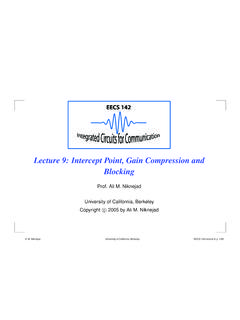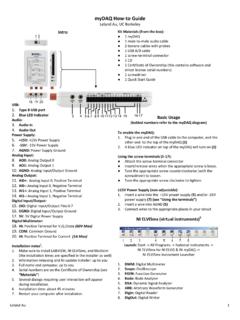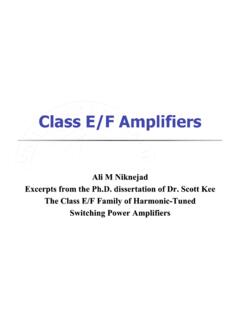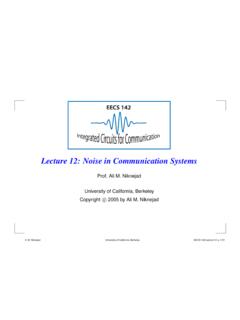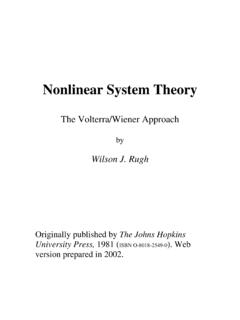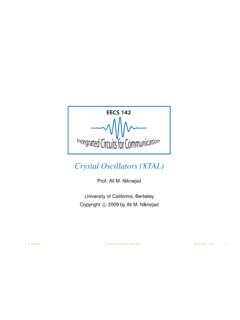Transcription of EECS 242
1 eecs 242 Scattering ParametersProf. NiknejadUniversity of California, BerkeleyUniversity of California, BerkeleyEECS 242 p. 1/43 Scattering Matrix123V+1V 1V+2V 2V+3V 3 Voltages and currents are difficult to measure directly at microwave opens , and it s hard to create an ideal open (parasitic capacitance andradiation). Likewise, aYmatrix requires shorts , again ideal shorts are impossibleat high frequency due to the finite inductance. Many active devices could oscillate under the open or short termination. Sparameters are easier to measure at high frequency. The measurement is directand only involves measurement of relative quantities (suchas the SWR or thelocation of the first minima relative to the load). It s important to realize that although we associateSparameters with highfrequency and wave propagation, the concept is valid for of California, BerkeleyEECS 242 p.
2 2/43 Power Flow in an One-Port The concept of scattering parameters is very closely related to the concept ofpower flow. For this reason, we begin with the simple observation that the powerflow into a one-port circuit can be written in the following formPin=Pavs Pr wherePavsis the available power from the source. Unless otherwise stated, let usassume sinusoidal steady-state. If the source has a real resistance ofZ0, this issimply given byPavs=V2s8Z0 Of course if the one-port is conjugately matched to the source, then it will draw themaximal available power from the source. Otherwise, the powerPinis always lessthanPavs, which is reflected in our equation. In general,Prrepresents the wastedor untapped power that one-port circuit is reflecting backto the source due to amismatch. For passive circuits it s clear that each term in the equation is positiveandPin of California, BerkeleyEECS 242 p.
3 3/43 Power Absorbed by One-Port The complex power absorbed by the one-port is given byPin=12(V1 I 1+V 1 I1) which allows us to writePr=Pavs Pin=V2s4Z0 12(V1I 1+V 1I1) the factor of4instead of8is used since we are now dealing with complex average power can be obtained by taking one half of the real component ofthe complex power. If the one-port has an input impedance ofZin, then the powerPinis expanded toPin=12 ZinZin+Z0Vs V s(Zin+Z0) +Z in(Zin+Z0) V s Vs(Zin+Z0) which is easily simplified to (where we have assumedZ0is real)Pin=|Vs|22Z0 Z0 Zin+Z inZ0|Zin+Z0|2 University of California, BerkeleyEECS 242 p. 4/43 Definition of Reflection Coefficient With the exception of a factor of2, the premultiplier is simply the source availablepower, which means that our overall expression for the reflected power is given byPr=V2s4Z0 1 2Z0 Zin+Z inZ0|Zin+Z0|2 which can be simplifiedPr=Pavs Zin Z0 Zin+Z0 2=Pavs| |2where we have defined , or the reflection coefficient, as =Zin Z0 Zin+Z0 From the definition it is clear that| | 1, which is just a re-statement of theconservation of energy implied by our assumption of a passive of California, BerkeleyEECS 242 p.
4 5/43 Scattering Parameter This constant , also called the scattering parameter of a one-port, plays averyimportant role. On one hand we see that it is has a one-to-one relationship withZin. Given we can solve forZinby inverting the above equationZin=Z01 + 1 which means that all of the information inZinis also in . Moreover, since| |<1,we see that the space of the semi-infinite space of all impedance values with realpositive components (the right-half plane) maps into the unit circle. This is a greatcompression of information which allows us to visualize theentire space ofrealizable impedance values by simply observing the unit circle. We shall find wideapplication for this concept when finding the appropriate load/source impedancefor an amplifier to meet a given noise or gain specification. More importantly, expresses very direct and obviously the power flow in thecircuit.
5 If = 0, then the one-port is absorbing all the possible power availablefrom the source. If| |= 1then the one-port is not absorbing any power, but rather reflecting the power back to the source. Clearly an open circuit, short circuit, or areactive load cannot absorb net power. For an open and short load, this is obviousfrom the definition of . For a reactive load, this is pretty clear if we substituteZin=jX| X|= jX Z0jX+Z0 = qX2+Z20qX2+Z20 = 1 University of California, BerkeleyEECS 242 p. 6/43 Relation between Z and The transformation between impedance and is a well known mathematicaltransform (see Bilinear Transform). It is a conformal mapping (meaning that itpreserves angles) which maps vertical and horizontal linesin the impedance planeinto circles. We have already seen that thejXaxis is mapped onto the unit | |2represents power flow, we may imagine that should represent the flowof voltage, current, or some linear combination thereof.
6 Consider taking the squareroot of the basic equation we have derivedpPr= pPavswhere we have retained the positive root. We may write the above equation asb1= a1whereaandbhave the units of square root of power and represent signal flow inthe network. How areaandbrelated to currents and voltage?University of California, BerkeleyEECS 242 p. 7/43 Definition ofaandb Leta1=V1+Z0I12 Z0andb1=V1 Z0I12 Z0It is now easy to show that for the one-port circuit, these relations indeed representthe available and reflected power:|a1|2=|V1|24Z0+Z0|I1|24+V 1 I1+V1 I 14 Now substituteV1=ZinVs/(Zin+Z0)andI1=Vs/(Zin +Z0)we have|a1|2=|Vs|24Z0|Zin|2|Zin+Z0|2+Z0|Vs| 24|Zin+Z0|2+|Vs|24Z0Z inZ0+ZinZ0|Zin+Z0|2or|a1|2=|Vs|24Z0 |Zin|2+Z20+Z inZ0+ZinZ0|Zin+Z0|2 =|Vs|24Z0 |Zin+Z0|2|Zin+Z0|2 =PavsUniversity of California, BerkeleyEECS 242 p. 8/43 Relationship betwena/band Power Flow In a like manner, the square ofbis given by many similar terms|b1|2=|Vs|24Z0 |Zin|2+Z20 Z inZ0 ZinZ0|Zin+Z0|2 =Pavs |Zin Z0 Zin+Z0 2=Pavs| |2=|a1|2| |2as expected.
7 We can now see that the expressionb= ais analogous to theexpressionV=Z IorI=Y Vand so it can be generalized to anN-port fact, sinceaandbare linear combinations ofvandi, there is a one-to-onerelationship between the two. Taking the sum and differenceofaandbwe arrive ata1+b1=2V12 Z0=V1 Z0which is related to the port voltage anda1 b1=2Z0I12 Z0=pZ0I1which is related to the port of California, BerkeleyEECS 242 p. 9/43 Incident and Scattering Waves Let s define the vectorv+as the incident forward waves on each transmissionline connected to theNport. Define the reference plane as the point where thetransmission line terminates onto theNport. The vectorv is then the reflected or scattered waveform at the locationof =0 BBBB@V 1V 2V Because theNport is linear, we expect that scattered field to be a linear functionof the incident fieldv =Sv+ Sis the scattering matrixS=0 BBB@S11S12 of California, BerkeleyEECS 242 p.
8 10/43 Relation to Voltages The fact that theSmatrix exists can be easily proved if we recall that the voltageand current on each transmission line termination can be written asVi=V+i+V iIi=Y0(I+i I i) Inverting these equationsVi+Z0Ii=V+i+V i+V+i V i= 2V+iVi Z0Ii=V+i+V i V+i+V i= 2V i Thusv+,v are simply linear combinations of the port voltages and currents. Bythe uniqueness theorem, then,v =Sv+.University of California, BerkeleyEECS 242 p. 11/43 MeasureSij123V+1V 1V 2V 3456Z0Z0Z0Z0Z0 The termSijcan be computed directly by the following formulaSij=V iV+j V+k=0 k6=j In other words, to measureSij, drive portjwith a wave amplitude ofV+jandterminate all other ports with the characteristic impedance of the lines (so thatV+k= 0fork6=j). Then observe the wave amplitude coming out of the portiUniversity of California, BerkeleyEECS 242 p. 12/43 SMatrix for a 1-Port CapacitorZ0C Let s calculate theSparameter for a capacitorS11=V 1V+1 This is of course just the reflection coefficient for a capacitorS11= L=ZC Z0ZC+Z0=1j C Z01j C+Z0=1 j CZ01 +j CZ0 University of California, BerkeleyEECS 242 p.
9 13/43 SMatrix for a 1-Port Capacitor (Direct Route)Z0C Let s calculate theSparameter for a capacitor directly from the definition ofSparametersS11=V 1V+1 Substituting for the current in a capacitorV 1=V IZ0=V j CV=V(1 j CZ0)V+1=V+IZ0=V+j CV=V(1 +j CZ0) We arrive at the same answer as expected=1 j CZ01 +j CZ0 University of California, BerkeleyEECS 242 p. 14/43 SMatrix for a 2-Port Shunt Element Consider a shunt impedance connected at the junction of two transmission voltage at the junction is of course continuous. The currents, though, differV1=V2I1+I2=YLV2Z0Z0ZL To computeS11, enforceV+2= 0by terminating the line. Thus we can be re-writethe above equationsV+1+V 1=V 2Y0(V+1 V 1) =Y0V 2+YLV 2= (YL+Y0)V 2 We can now solve the above eq. for the reflected and transmitted waveV 1=V 2 V+1=Y0YL+Y0(V+1 V 1) V+1V 1(YL+Y0+Y0) = (Y0 (Y0+YL))V+1S11=V 1V+1=Y0 (Y0+YL)Y0+ (YL+Y0)=Z0||ZL Z0Z0||ZL+Z0 University of California, BerkeleyEECS 242 p.
10 15/43 Shunt Element (cont) The above eq. can be written by inspection sinceZ0||ZLis the effective load seenat the junction of port 1. Thus for port 2 we can writeS22=Z0||ZL Z0Z0||ZL+Z0 Likewise, we can solve for the transmitted wave, or the wave scattered into port2S21=V 2V+1 SinceV 2=V+1+V 1, we haveS21= 1 +S11=2Z0||ZLZ0||ZL+Z0 By symmetry, we can deduceS12asS12=2Z0||ZLZ0||ZL+Z0 University of California, BerkeleyEECS 242 p. 16/43 Conversion Formula SinceV+andV are related toVandI, it s easy to find a formula to convert forZorYtoSVi=V+i+V i v=v++v Zi0Ii=V+i V i Z0i=v+ v Now starting withv=Zi, we havev++v =ZZ 10(v+ v ) Note thatZ0is the scalar port impedancev (I+ZZ 10) = (ZZ 10 I)v+v = (I+ZZ 10) 1(ZZ 10 I)v+=Sv+ We now have a formula relating theZmatrix to theSmatrixS= (ZZ 10+I) 1(ZZ 10 I) = (Z+Z0I) 1(Z Z0I)University of California, BerkeleyEECS 242 p. 17/43 Conversion (cont) Recall that the reflection coefficient for a load is given by the same equation!
